Chapter 9. Working with the Sidebar and Gadgets
In This Chapter:
- Understand the Sidebar’s purpose
- Work with gadgets on your Sidebar
- Add new gadgets to your computer
- Change Sidebar and gadget options
- Look for more information about writing your own gadgets
The Windows Sidebar is a feature new to Vista. When enabled, it resides on an area of your screen that you can make visible at all times, typically as a vertical column with icons on it along the right side of your screen. On the Sidebar, you can place gadgets—small programs that give you routine information that you like to have available such as a calendar, calculator, or stock quotes.
The Sidebar always puts information at hand and is just one of the many ways you can customize Windows Vista to give you the data you need in the manner you want it. Throughout this chapter, you’ll learn ways to customize your Sidebar and add gadgets to it.
A Sidebar Overview
Figure 9.1 shows the Sidebar on a Vista desktop. As you can see, the Sidebar itself is see-through, so if there were no gadgets on it, you wouldn’t know it was there. Also, sometimes a window might position itself under the Sidebar area, and being able to see between the Sidebar gadgets enables you to see what’s under the Sidebar.
Figure 9.1. Your Sidebar sits against an edge of your screen and makes small programs called gadgets available.
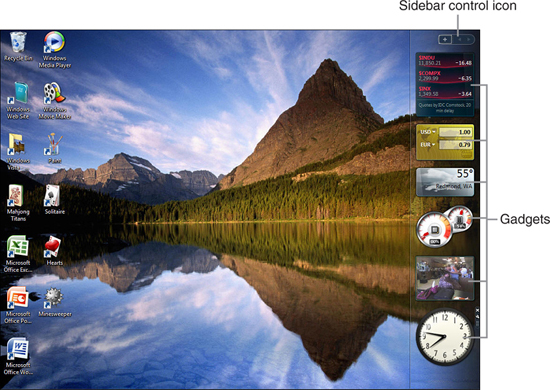
One of the nicest features of the Sidebar is its ability to load and stream live data. The Sidebar can display information that you’d otherwise have to open Internet Explorer to find, such as stock quotes and a weather summary.
When you first start the Sidebar, you’ll probably see at least two gadgets there. Depending on what’s happened on your computer before or how your computer’s manufacturer set up Vista on your computer, you could see additional gadgets or perhaps none at all. The clock is almost always one of the gadgets set to reside on a Sidebar. Other gadgets, such as the Stock quote gadget, might also appear there.
Your Sidebar might already be showing but if not, open your Start menu’s Accessories option and select Windows Sidebar. To see which gadgets are currently running, right-click the Sidebar icon on your Taskbar’s notification area and select Properties from the pop-up menu. Click the View List of Running Gadgets button, and the View Gadgets dialog box shown in Figure 9.2 opens. Each item in the list is a separate gadget.
Figure 9.2. You can always check to see the names of the gadgets currently running.
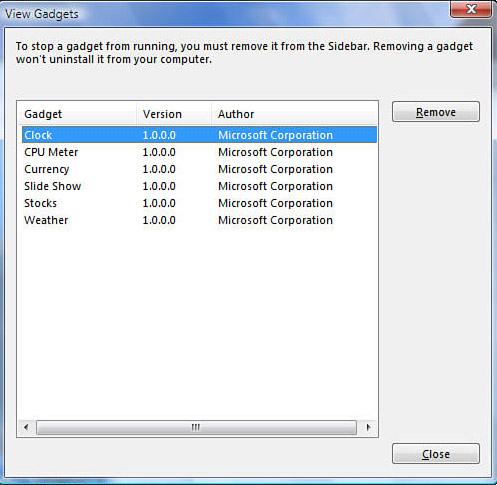
By the Way
Gadgets can run on your desktop’s Sidebar, your Vista desktop itself, or often on a Windows Sideshow screen on the outside of some laptops and other peripheral computer equipment. Chapter 4, “Starting and Stopping Windows,” describes Sideshow.
Adding Gadgets to Your Sidebar
Before you can add a gadget to your Sidebar, you have to know which gadgets are currently available on your system. Over time, you will obtain gadgets from www.Microsoft.com and other websites. To see what gadgets you currently have installed, right-click the Sidebar’s icon on your Notification area and select Add Gadgets.
The Add Gadgets dialog box shown in Figure 9.3 will appear. The gadgets shown in Figure 9.3 are a sample of gadgets that Microsoft shipped with Windows Vista. The next section explains how to download additional gadgets from Microsoft. Other sites will supply gadgets for your Sidebar as well as Microsoft.
Figure 9.3. Each gadget has its own options dialog box with which you can control the gadget’s properties.
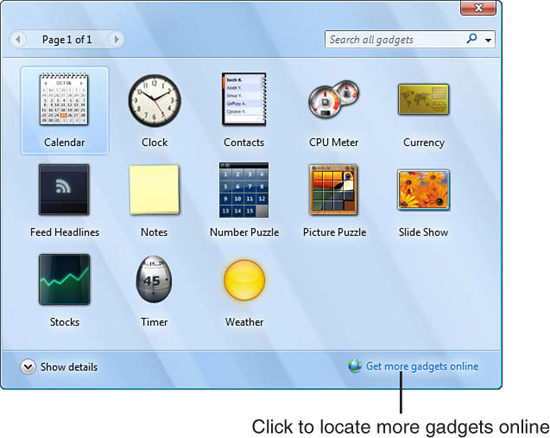
By clicking the Show Details option, you can learn more about a selected gadget as shown in Figure 9.4. The Show Details button produces an Information bar that lists the selected gadget’s version number and distributor. To hide the Information bar click the Hide Details link.
Figure 9.4. You can view additional information about a selected gadget such as its version number and distributor.

To add a gadget to your Sidebar, double-click the gadget’s icon. To remove a gadget, just point to the gadget on your Sidebar to display its Close and Options buttons and click the Close button.
By the Way
A gadget begins running the moment it appears in your Sidebar. You need to do nothing more to trigger the gadget’s operation.
If you ever want to remove a gadget from your system, right-click the gadget’s icon in the Add Gadgets dialog box and select Uninstall.
Did you Know?
Instead of removing a gadget from your Sidebar, you can drag the gadget from the Sidebar to another location on your screen. The gadget floats over your programs and is not anchored on your desktop.
Download Additional Gadgets from Microsoft
You should search the Internet for companies that sell or give away new gadgets you might find beneficial. Microsoft offers additional gadgets and you can see what Microsoft has by clicking the Get More Gadgets Online link in your Add Gadgets dialog box.
A web page like the one in Figure 9.5 appears. You can scroll down the list of gadgets to locate one or more you’re interested in. You’ll find games, utilities, and more.
Figure 9.5. Microsoft and other companies offer websites from which you can download additional gadgets to your computer.
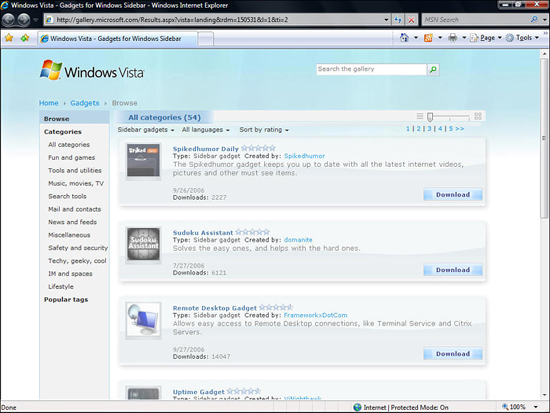
Click the Download button next to a gadget you want to install on your computer. When the File Download dialog box appears, you can select Save to save the gadget to a folder on your computer or select Open to install the gadget directly from the website without saving the gadget’s installation file on your computer.
Did you Know?
The default location for the gadgets you download is your Documents folder. Instead of saving the new gadgets there, you can create a new subfolder named Gadgets and save the gadgets to that folder to keep your downloaded gadgets together.
When the download completes, click the Open button. (Assuming that you saved the gadget to your computer. If you didn’t, the gadget begins installing automatically.) The gadget will install itself on your computer and become available in the list of gadgets when you display the Add Gadgets dialog box.
Modifying Gadget Properties
Most gadgets running in your Sidebar have three buttons that appear in their upper-right corner when you point to them with your mouse. These are a Close button designated with an X, an option button designated with a wrench icon, and a grab button which you can click to drag the gadget to another location on your screen or elsewhere in your Sidebar.
Clicking the Close button closes the gadget and removes it from your Sidebar. Clicking the Options button opens a dialog box with which you can control the various options that gadget supports.
Clicking the Options button on the World Clock gadget produces the World Clock options dialog box shown in Figure 9.6. There you can select a time zone that you want to display from a list of worldwide time zones. In addition, you control whether the clock displays a second hand moving around the clock in real-time and you can select a time zone.
Figure 9.6. Enter a clock name and a time zone for your Sidebar’s world clock.
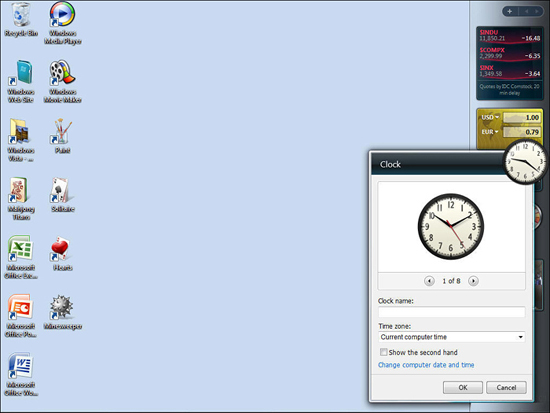
If your Sidebar fills up with gadgets, Vista creates additional pages for it. To see the gadgets that aren’t currently in view, click the left or right arrow at the bottom of your Sidebar’s control button panel.
Organize Your Gadgets
Vista supports several ways you can organize and use your gadgets. You don’t have to keep them on your Sidebar to use them, but the Sidebar keeps them together and always available. You can add a gadget to your desktop, too.
To move a gadget from your Sidebar to your desktop, drag the gadget’s grab button and drag the gadget away from the Sidebar. If you want all gadgets placed on your desktop, you should hide your empty Sidebar from view so that it won’t get in your way. To hide your Sidebar, right-click over an empty spot toward the bottom of your Sidebar and select Close Sidebar from the contextual menu. Your Sidebar icon still remains on your Taskbar’s notification area where you can display the Sidebar again if you wish.
Modifying Your Sidebar Properties
Your Sidebar might become hidden without you intending for that to happen. If you maximize a program or folder window after you display your Sidebar, that window will appear on top of your Sidebar. If you want your Sidebar to remain in view no matter what else you do (which is often the reason why you want the Sidebar to begin with), right-click over an empty spot at the bottom of your Sidebar and select Properties. The Windows Sidebar Properties dialog box opens as shown in Figure 9.7.
Figure 9.7. You can control the Sidebar’s appearance and behavior.
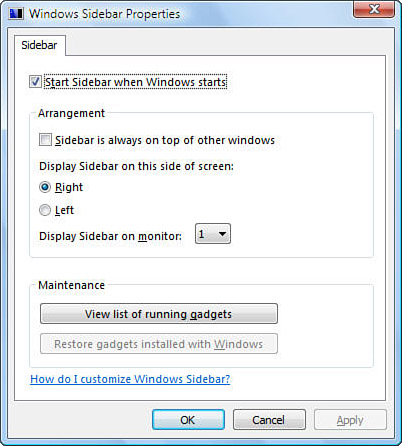
From the Windows Sidebar Properties dialog box, you can control several aspects of your Sidebar. To keep your Sidebar on top of all windows, even those you maximize, select the option labeled Keep the Sidebar on Top of Other Windows. After you select that option, any windows you maximize afterward will maximize only to the extent of your screen’s width that doesn’t include your Sidebar.
Did you Know?
If you don’t want your Sidebar to stay on top of all other windows at all times but you want to see your Sidebar temporarily, right-click the Sidebar gadgets icon in your taskbar’s notification area and select Bring Gadgets to Front. Vista instantly places your sidebar on top of all open windows but does not set up your Sidebar to stay on top of all windows you subsequently open.
The option labeled Start Sidebar When Windows Starts will, when checked, ensure that your Sidebar remains open the next time you start Windows. You won’t have to start Sidebar manually because it will appear when your computer starts.
By the Way
Your Sidebar placement and gadgets affect only your user account and not the accounts of others who use your computer. Their Sidebar settings are unique to their accounts.
The default location for your Sidebar is the right side of the screen, but if you click the option labeled Left, Vista places your Sidebar to the left of your screen.
If you have multiple monitors, you can determine which monitor Vista places your Sidebar on. Click the arrow next to the number for the Display Sidebar on Monitor option to use the selected monitor for the Sidebar. If you use three monitors, for example, you might want your Sidebar placed against the right edge of the far right monitor’s screen or perhaps the left edge of the far left screen. Using the Windows Sidebar Properties dialog box, you control the exact placement on the monitor that works best for your needs.
Did you Know?
If you’re a programmer, you can write gadgets and share them with others. Microsoft provides support for writing new gadgets at http://microsoftgadgets.com/Build. Figure 9.8 shows the website, and as you can see from the menu across the top, the site contains a lot of resources for anyone who wishes to write their own gadgets or gadgets for others to use. A gadget consists of HTML and script code. To see the exact steps required to write, test, and run new gadgets, this page will walk you through the entire process: http://microsoftgadgets.com/Sidebar/DevelopmentOverview.aspx.
Figure 9.8. The Gadget Builder Depot website contains the answers you need to build your own gadgets.

Looking at Vista’s Gadgets
One of the best ways to learn how the Sidebar works is to use it. The following sections review a few of the gadgets that Microsoft supplies with Windows Vista.
The Feeds Headlines Gadget
The Feeds Headlines gadget, shown in Figure 9.9, supports RSS (an acronym for Really Simple Syndication, which allows you to receive live updates from your favorite blogs and websites. Chapter 38, “Staying in Touch with RSS and Instant Messaging,” explains more about RSS feeds and how you can subscribe to them on your favorite websites.
Figure 9.9. Get live RSS streaming information from the Internet.
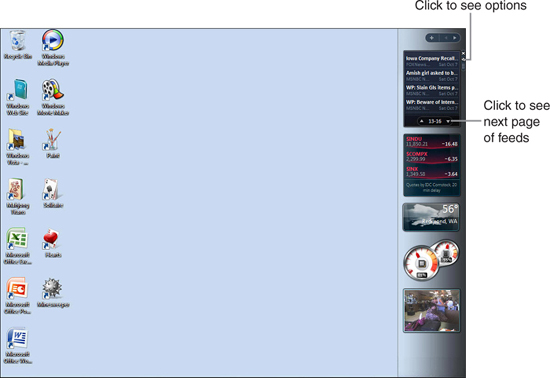
The Feeds Headlines gadget defaults to showing you Internet Explorer–related information. If you subscribe to RSS feeds in Internet Explorer, the Feeds Headlines will display those feeds as well.
When you click the wrench icon to display the options window, all RSS feeds that you subscribe to will be presented in a scrolling list. Select an RSS feed and the Feeds Headlines gadget displays information from that feed.
The Notes Gadget
The Notes gadget, shown in Figure 9.10 with its option window open, is an always-ready notepad that you can jot notes on while you work. The Notes gadget is nice because you don’t have to open Word or WordPad to type quick notes that you want to refer to later.
Figure 9.10. Notes is a gadget that’s always ready to record your notes like a sticky pad next to your keyboard.
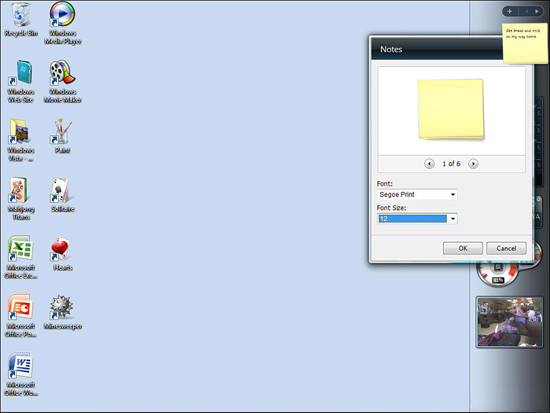
To use the Notes gadget, click on the Notes gadget and begin typing. You cannot adjust the side of the Notes except if you drag the Notes gadget off your Sidebar, Vista will increase the size a little for better viewing. If a note takes more than the current note size, the note scrolls down as you type past the bottom line.
Notes can keep track of multiple notes, not just one. When you’re ready to add another note to your Notes pad of notes, click the plus sign and a blank note appears on top of the pad. Click the Note gadget’s left and right arrows to move back and forth among the notes that you’ve created.
The World Clock Gadget
Earlier in the chapter you saw the World Clock gadget. The clock shows the time for any time zone you select. A second hand display is also available in the options window.
By the Way
If you have friends or family who are traveling, you could display their time zone in the World Clock. You’ll be able to keep track of their time and better know the hours when you could call them. Changing your Sidebar’s World Clock’s time zone doesn’t change your computer’s time zone shown in the notification area of your taskbar.
The Slide Show Gadget
The Slide Show gadget is another Vista-supplied Sidebar gadget. When you first install Vista and display the Sidebar, it might not hold the Slide Show. But you can easily add Slide Show by following the steps in the previous section, “Adding Gadgets to Your Sidebar.” Figure 9.11 shows the Slide Show gadget atop the Sidebar with its Options window open.
Figure 9.11. The Slide Show gadget steps through your pictures.

When you point to the Slide Show gadget, a set of control buttons appear at the bottom of the display. With these controls, you can do the following:
- Look at the picture displayed before the current one.
- Pause the display on the current picture.
- Move to the next picture. (This is useful for stepping through the pictures at a faster speed than the current rate.)
- Reveal the current image (meaning, in Slide Show talk, that you display the current picture in its own program window in your Photo Gallery Viewer).
If you want to display images from a folder other than your Pictures folder (which is the folder Vista defaults to), click the check mark to display the Slide Show’s options window and change the Directory entry to the folder you want to use for the Slide Show. You can change the speed of both the fade from image to image and the amount of time Slide Show uses to display each picture before moving to the next one.
Chapter Wrap-Up
The Sidebar is just another tool Windows Vista gives you to get work done. The Sidebar in and of itself does little more than stay against one side of your screen and run little programs, called gadgets, that you can refer to as you use your computer. While the Sideshow gadgets are running, you can open other programs and use Windows just as you’d normally use Windows.
Windows Vista provides lots of programs like gadgets that help make you more productive. Your Start menu’s Accessories menu option is filled with other programs. In the next chapter, you’ll learn about the accessory programs that come with Vista.
